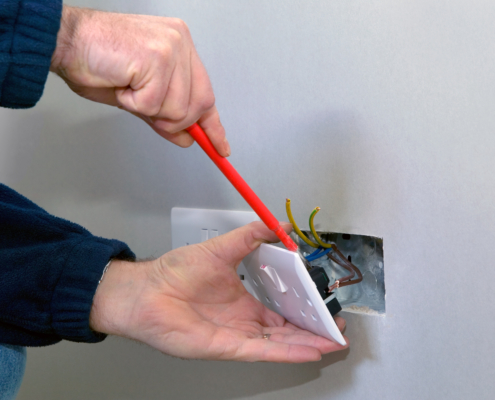Customized BRE Electrical Solutions for Houses and Organizations
Customized BRE Electrical Solutions for Houses and Organizations
Blog Article
Demystifying Electric Setup: Recognizing Codes and Laws for a Lawful and Safe Arrangement
In the realm of electric installation, adherence to codes and guidelines is vital to guarantee both validity and safety. The journey to demystifying electric installation goes past mere familiarity with laws; it necessitates an extensive understanding of exactly how to apply secure electrical techniques successfully.
Significance of Electrical Codes
The adherence to electric codes is crucial in ensuring the safety and security and integrity of electric setups. Electrical codes function as a set of requirements and guidelines that dictate the correct layout, setup, and upkeep of electric systems. These codes are developed to reduce the risk of electrical threats, fires, and various other security issues that may occur from malfunctioning electric job.

Moreover, electrical codes are regularly updated to incorporate new technologies, best techniques, and safety measures. Staying upgraded with these codes is vital for specialists in the electrical sector to make sure that their work satisfies the most recent safety and security criteria. Inevitably, the significance of electrical codes exists in developing a protected and effective electric infrastructure that profits both people and communities.
Secret Laws for Safety And Security
Numerous essential policies control the security standards in electrical installments. One crucial guideline is the National Electric Code (NEC), which supplies guidelines for secure electrical design, installment, and examination to secure individuals and property from electric hazards. The NEC covers facets such as circuitry methods, grounding, overcurrent defense, and equipment setup to make certain a safe electric system.
One more critical guideline is the Occupational Safety And Security and Health Administration (OSHA) requirements, which focus on the safety of employees involved in electric setups (BRE Services). OSHA policies consist of needs for proper training, safety treatments, and individual safety tools to avoid office mishaps and injuries
Moreover, the International Electrotechnical Compensation (IEC) requirements aim to balance electric installation policies on a worldwide range. These requirements address issues like electrical devices safety, electromagnetic compatibility, and energy effectiveness to advertise uniformity and safety and security in electrical installments worldwide.
Conformity with these essential policies is important to make sure the safety and legitimacy of electrical installations, shielding both individuals and residential property from the risks linked with electrical energy.
Understanding National Electric Code
Key guidelines such as the National Electrical Code (NEC) give important standards for secure electric layout, installment, and evaluation to ensure the security of people and building from electric dangers. The NEC, additionally referred to as NFPA 70, is an extensive collection of criteria for electrical setups that are updated every 3 years. It is created by the National Fire Defense Association (NFPA) and is widely embraced across the USA.
The NEC covers numerous facets of electrical work, consisting of wiring techniques, grounding, overcurrent defense, and equipment setup. It aims to secure people and property by addressing potential risks related to electric systems. Conformity with the NEC is typically applied by regional authorities having territory (AHJs), such as building code authorities and examiners.
Understanding the NEC is essential for electrical contractors, developers, and assessors to make sure that installations fulfill the needed safety and security demands. By sticking to the NEC guidelines, experts can assist prevent electric accidents and ensure the reliability BRE Electrical Solutions of electrical systems in household, commercial, and industrial settings.

Conformity With Regional Building Ordinance
Recognizing and sticking to local building codes is necessary for guaranteeing the safety and conformity of electrical setups within a specific jurisdiction. These codes describe certain needs for electric setups, such as the type of electrical wiring to be utilized, positioning of outlets, grounding approaches, and tons abilities.
When it comes to electrical setups, failure to abide by neighborhood structure codes can result in severe consequences. Non-compliant installations might posture security threats, increase the danger of electric fires, and bring about costly fines or legal concerns. In addition, insurer may reject to cover damages arising from installments that do not satisfy neighborhood building code demands. It is critical for electrical contractors and contractors to stay informed around and purely adhere to the regional structure codes relevant to their projects.
Making Certain Safe Electrical Practices
Practicing rigorous adherence to established security methods is critical in the field of electrical installments to reduce prospective threats and make sure the wellness of individuals and residential properties. Safety in electric work includes numerous facets, starting with the correct training of employees associated with installation, upkeep, and repair service. It is necessary to comply with manufacturer guidelines carefully when taking care of electric components and devices. Before starting any kind of work, it is vital to conduct a detailed danger assessment to determine possible dangers and apply safety nets. Utilizing personal safety equipment (PPE) such as protected gloves, shatterproof glass, and non-conductive shoes is non-negotiable to protect versus electrical shocks and arc flashes. Regular equipment assessments, testing, and maintenance routines are indispensable to detect and rectify mistakes prior to they intensify into safety threats. Adherence to appropriate lockout-tagout procedures during upkeep activities is essential to prevent unexpected energization of circuits. By focusing on risk-free techniques, electric installments can work successfully while reducing the likelihood of crashes or damage.
Conclusion
To conclude, adherence to electric codes and regulations is vital for ensuring the safety and validity of electrical setups. Understanding the National Electric Code and compliance with regional building codes are necessary for a safe setup. By complying with these guidelines and practicing risk-free electrical methods, people can avoid possible threats and ensure the proper performance of their electric systems.
Report this page